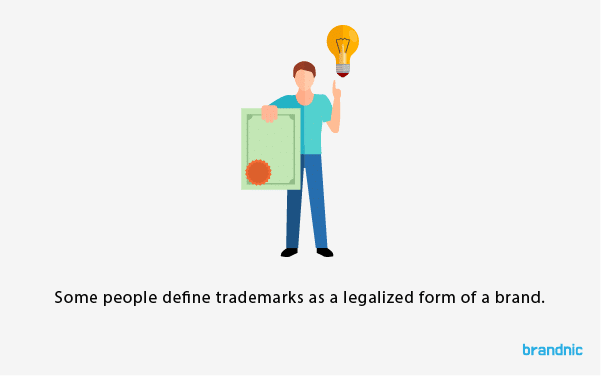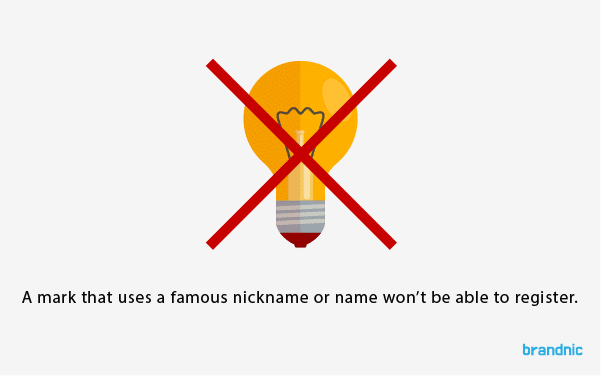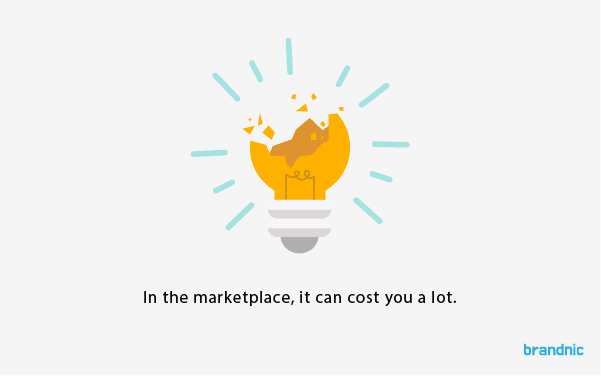Read Time: 12 minutes
In this guide, you’ll learn the basics of trademark infringement as well as some examples of how to avoid it.
Table of Contents
1. What is Trademark Infringement?
2. Some elements about Common Law Trademark Infringement
3. Likelihood of Confusion
4. Why you should be Aware of Trademark Infringement
5. Trademark Dilution VS Trademark Infringement
6. A guide to Avoid Trademark Infringement
7. Keep your business safe
8. Trademark Infringement FAQ
9. Protect your mark with Brandnic
What is Trademark Infringement?
We hear about trademark violations from time to time in the marketplace, but what exactly are they?
Trademark infringement occurs when someone illegally uses a trademark or service mark without authorization from the original owner. This can lead to confusion between marks and loss of public image.
Copyright protects creative work, a patent helps inventors and trademarks prevent others from using the identity of a business.
Remember that logos, phrases, slogans, colors, and words can be considered trademarks.
It is because trademarks help identify many features of a company that there is a likelihood of confusion if a similar mark starts using them.
Needless to say, infringement cases can be considerably expensive since the owner must be able to prove that the infringers confuse the target audience.
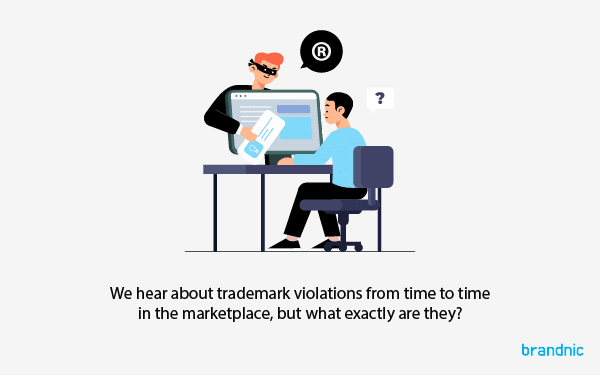
Trademark violation is serious and can cause damage to your brand.
For example, the mark holder must use experts, data and a lot of research to prove that the infringement damage is real.
There are some other factors that allow a trademark infringement claim to be accepted in court:
1. The mark must be valid to be protected by a court.
2. The person that started the infringement case must own the mark.
3. The mark of the alleged infringer must be in commerce.
It is important for you to know that there is a law that may pose a threat to any corporation even if it has invested a lot in the trademark.
We are talking about the common law trademark infringement and it’s something you should definitely check.
Elements about Common Law Trademark Infringement
There are some factors that can protect your business, but they can also mean future problems if you ignore them.
No matter what type of business you have, learning of how a common law trademark works can always be useful to protect your business efficiently.

Protecting your business.
What is a trademark Common Law Infringement?
If you are wondering what constitutes trademark infringement, you should know that common law is one of its categories.
In other words, it’s a type of protection for IP even if it hasn’t been registered as a trademark.
This law varies depending on the country, but in the USA for example; it starts when the mark is used in commerce within the country.
Experts suggest that a business can have a competitive advantage when it decides to use technology software to have accurate legal analytics about the available marks. However, it should always be used with a professional team who can guide you through the process.
Other factors you should be aware of:
1. The first to use it has the advantage
In common law, there’s some confusion about what is more important: to file first or to use first.
These two are part of the trademark infringement elements, but their importance relies on the country where it belongs. For instance,
Some countries such as the USA, Ireland and the UK are considered “first to use” since brand names are given protection over other marks without registering to any trademark office like the United States Patent Trademark Office (USPTO).
On the other hand, there are countries that give more importance to registered trademarks even if they aren’t the original owners.
A mark that has been used previously has a chance to win a trademark violation claim in certain cases.
Therefore, you should always research about the trademark registration process before purchasing a trademark.
2. Limited Protection
So far we’ve mentioned that a common law offers protection to those who can prove that have previously used a mark. However, it offers limited protection that many people aren’t aware of.
A trademark can be classified in more than 40 different categories.
Each of them grants legal usage for specific kinds of products or services. When you register a trademark, you’ll be able to maintain legal ownership over these goods.
Nevertheless, common law doesn’t protect trademarks under any specific category nor is able to collect damages from a trademark infringement dispute.
A registered trademark can protect a company’s products and services since they are part of a particular category.
Hence, you can’t assume that your mark will be as protected as one that is legally registered.
3. Domain Usage Matters
Nowadays, a company isn’t a company if you can’t find it on the internet. In fact, there’s more legal confusion in relation to domain names as businesses continue to create their websites.
Domain names are indeed protected by the common law, but luckily they are the easiest to search before using it as your trademark.
At first, there were only a few domain extensions such as “.com” or “.edu”, but now we have varied domain types that sometimes can be “too similar” for their own good.
Check the domain you want to use before choosing your trademark or else you may run into a domain common law trademark infringement.
Common law can be a way to end up in an infringement case, but there are other ways to start a claim if you find enough proof of it.
Likelihood of Confusion
In order to start an infringement case, the mark holder must demonstrate that there is a likelihood of confusion according to some elements that most courts consider:
Whether the two marks are too similar including color and logo similarities.
How similar the products and services are. They also check the marketing strategies that are used.
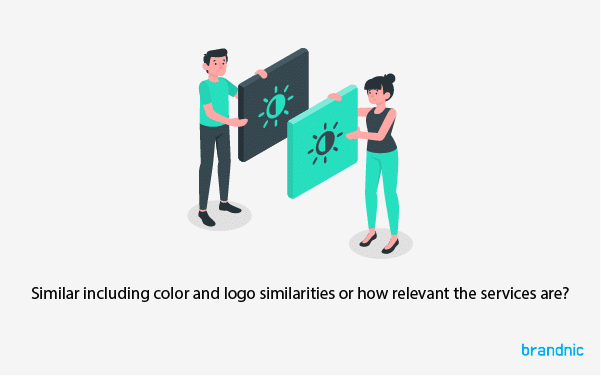
The two similar marks must not be in the same business industry.
How strong the plaintiff is. A court checks the recognition that the mark has gained over the years.
- Evidence of confusion by the target audience.
- A well-justified intention of the defendant.
- The location and proximity of the two businesses.
- How consumers care about the two businesses.
- How likely the companies are to expand in the marketplace.
It is essential to understand that some of these factors are arguable. Moreover, it is possible to have two identical marks being used in commerce even if they are in the same geographic place.
This is only allowed when the goods and services are different enough to avoid confusion.
For instance, Several companies can operate under the name “Delta” if they are as different as an airline company to a plumbing one.
Why you should be Aware of Trademark Infringement
It is difficult sometimes to understand the importance of trademarks in a business. In fact, it can actually be the most valuable asset in order to maintain your brand’s strength.
You should be aware of trademark infringement damages since it has many factors that are easy to omit when establishing a company.
It’s no surprise how many infringement cases are claimed due to a lack of research that could have avoided confusion between marks.
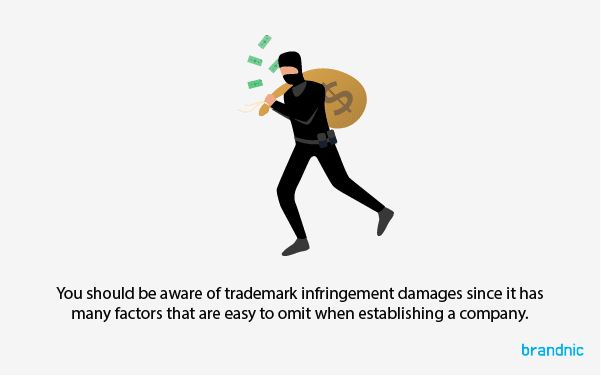
Being aware of trademark infringement.
Learning about trademark infringement lawsuit helps you choose trademarks that are distinct, but catchy enough to succeed in the marketplace.
Furthermore, the average cost of a trademark claim can vary between $130,000 and $800,000. What’s worse, these cases can last several years.
Just think about how large companies have suffered the consequences of infringing on a trademark? … You probably can’t afford the risks if you are about to build a startup. Either way, here you have some other reasons why you should read everything you can about legal trademarks.
Trademark Violation Penalties
Infringing trademarks are taken very seriously and are often related to deceptive trade practices. Some of the legal consequences that you may face:
An injunction
It means that the legal owner can send a notification requiring the infringer to stop producing and using any goods and services in relation to the trademark until it is authorized by the owner. In the worst scenario, a court can forcefully make the other business to stop working and impose a fee.
Monetary loss
Once the owner proves that there have been monetary damages for violation of his trademark, he will be able to recover them from the profit of the “violator”. There will be an additional fee depending on whether the infringer was using the trademark intentionally.
Trademark Dilution VS Trademark Infringement
You may hear about trademark dilution while reading about infringement cases. They are actually very similar to one another, but it’s essential to understand the difference between them.

Trademark infringement vs infusion.
For instance, Trademark dilution occurs when a famous trademark loses its uniqueness in the marketplace. As well as in infringement cases, most cases of trademark dilution include unauthorized use of trademarks related to products and services.
Trademark dilution damages can be classified into two different types:
Blurring
A mark that weakens another company’s target audience’s perception by using similar goods or services can be claimed to be “blurring” the original business.
The mark is likely to be related to the other similar company which can considerably harm its growth.
For example .. Starbucks Corporation sued Wolfe’s Borough Coffee, Inc for using a trademark for its coffees called “Charbucks Blend” which, according to Starbucks, diluted its brand name. Interesting fact: This case was one of the few considered both blurring and tarnishment.
Tarnishment
On the other hand, a tarnishment case occurs when a mark is related to another similar company that has inferior goods or services.
For example .. If a business sells T-shirts with xenophobic messages under the mark “eBay”, it will mean that the T-shirts might tarnish eBay’s reputation incredibly fast.
Courts look at some important factors in order to determine whether a mark is famous before claiming for a trademark dilution:
- How long the mark has been used.
- How long it has been advertised in the marketplace.
- The geographic place where it has been used.
- The level of uniqueness of the mark.
- How well recognized the mark is.
- The marketing channels that were used to advertise the mark.
- Whether the mark was used by third parties.
- Whether the mark is legally registered.
A guide to Avoid Trademark Infringement
We previously mentioned some of the risks that a trademark infringement lawsuit brings, therefore let’s check some examples and tips on how to avoid this kind of situation.
Experts always mention the importance of the “intent” and how it can determine the result of a case.
For instance,
The Academy Awards once sued GoDaddy for selling domain names such as “20Oscars.com”. The lawsuit claimed that GoDaddy was intentionally profiting from the name of the Academy Awards.

Learning to avoid trademark mistakes.
In spite of this, the court supported GoDaddy because they proved that they didn’t have any dishonest intent to profit from these sales. This case was considered a bad strategy from the popular awards, yet it shows how useful research can be.
Adidas and Forever21, Lucky 13 and Taylor Swift, D2 Holdings and House of Cards are some other well-known cases that were saved by an “honest intent”.
Here you have the most important steps to avoid trademark infringement.
Understand trademarks
Understanding trademarks is not something you can do in a day. There are actually many legal aspects that you should take into account before even thinking about purchasing one.
For example, there can be cases of logo infringement cases as well as many trademark laws that can make you more confused.
If you really want to learn about trademark violations and ways to avoid it, you have to study the whole world where it came from.
We can ensure you that it is completely worth it. Trademarks are crucial to help you maintain the ownership of your business, so it’s something to take very seriously.
Do your research
After learning the basics of trademarks, you should know that it is essential to check the list of brand names you want online before registering them as trademarks. Look for similar names, logos or even products and services.
Even your most creative ideas can already be taken.
Hence, you should look for several pages of results and change of brand name if necessary.
Better hire an Expert
We know that as the owner of a startup the last thing you want to do is to spend more money on building your company.
Nevertheless, trademarks can be complex and even though you may understand everything, hiring an expert will guarantee a safe trademark registration without any future dispute. It’s an investment that can save you money and time.
We always suggest keeping any doubt away by talking to experts who know about this topic.
Remember that when it’s about legal business, research can be your greatest tool.
Unfortunately, trademark infringement defenses don’t work all the time and sometimes it’s easier to rebrand your company with a new mark name. We always recommend considering if you really want to pursue the issue.
Moreover, it is possible to make your business completely unique so you won’t worry about trademark infringement anymore.
Keep your business safe
Registered trademarks are likely to be benefited from the law. This is also crucial when you find out that someone else is using your mark.
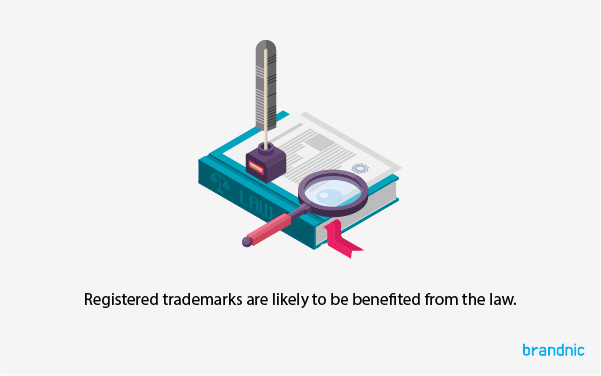
Safeguarding your business.
In this case, you can send a cease and a desist letter, but if the other party doesn’t respond, you can then go to an attorney and file a lawsuit.
A trademark infringement letter can be the first step to a long legal process that can save your company’s performance.
Therefore, have your entire paperwork ready before you decide to make the first move.
Take into account that unregistered trademarks probably won’t act as quickly and effectively as a business that was legally registered.
Useful tips to choose a trademark that is safe
Trademarks were created to avoid customer confusion and distinguish a business from its competitors. Hence, choosing the right mark name ensures that your business stays safe in the marketplace.
There are several elements such as sound, sight, and colors that can make a unique trademark. However, you should avoid certain types of names for building a successful company.
Let’s look at some of them ….
Determine your company’s purpose
The first step to create a unique trademark is to study your business. This includes studying your potential competition and the customers in your industry so you can then determine your company’s purpose.
In other words, you should know what message you want to convey to your audience and how you want them to perceive your services and goods.
Brainstorm a list of ideas
Uniqueness is the way of success, therefore having different ideas related to your company’s goals will give you a better understanding of what you are looking for.
Begin by thinking about any word, sound or image that matches your business and writes it down. It doesn’t have to make much sense at first, the important point here is to start creating the essence of your startup.
Avoid descriptive words
A common mistake is to create a name that specifically describes what your business does. Determining your company’s goal should inspire you, but it doesn’t mean you have to use “Best Chocolate Bars” as your trademark.
Be creative and avoid using geographical names and surnames as well. For example, “Joe’s NY Coffee” sounds uninteresting and it’s very likely to have been used before.
Trademark Infringement FAQ
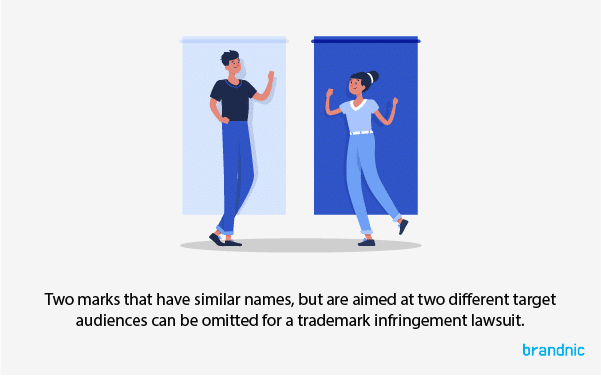
Important tips.
1. Do trademark offices reject similar trademarks?
Many people rely on the idea that trademark offices won’t accept similar trademarks, but it usually isn’t the case. A trademark office won’t allow an identical trademark to be registered, but it won’t tell you if a similar trademark was created. Hence, it is recommended to check the marketplace regularly in order to detect any trademark that can affect yours.
2. What can I do if I’m accused of trademark infringement?
Alleged infringers can claim that they are using the trademark under the collateral or fair use as a defense.
Collateral use means that you have the trademark as part of other inventions while the fair use lets you use another’s trademark as long as it’s for teaching or news reporting.
3. Can I change an existing logo to avoid a trademark violation?
The answer to this question can vary depending on the case. Remember that infringement cases are subjective and even if you manage to change a logo to avoid Google Images detectors, the original company can still prove that you are damaging its public image.
You should take into account that copyright protects any artistic expression such as logos. The only way to avoid infringing on a copyright is to use a logo that contains words instead of images.
4. How can I check the similarity of marks?
You should check how similar two marks are depending on their appearance, pronunciation, and meaning. A court also considers how the public perceives the mark.
As we mentioned above, two marks that have similar names, but are aimed at two different target audiences can be omitted for a trademark infringement lawsuit.
Get a Protectected mark with a Domain name from Brandnic
Keeping your business safe is our priority. In fact, we offer more than a thousand of brand names that are unique and catchy to have a successful start in any industry. Moreover, you will receive a free logo related to the brand name you chose.

Domain name with registered trademark rights from brandnic.
We are aware of the importance of registering your mark, therefore every purchase includes common law trademark and trademark monitoring.
At Brandnic, you’ll have a team of experts that can guide you through the whole process to ensure our customers a 100% secure guaranteed.
Moreover, we are available 24/7 to answer any queries you have. Visit us today and check some great trademark ideas.










